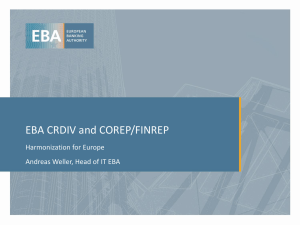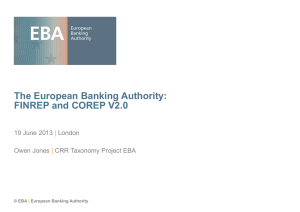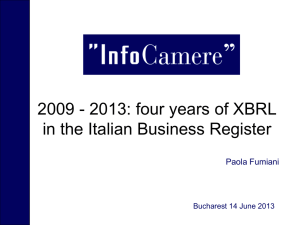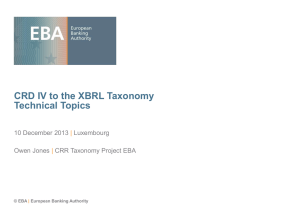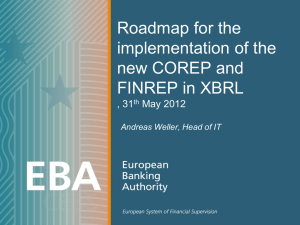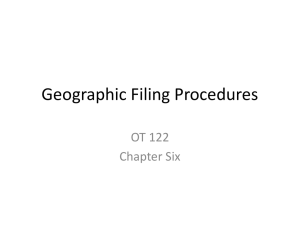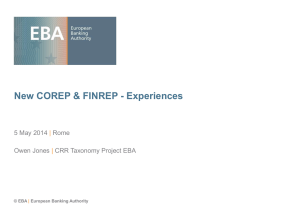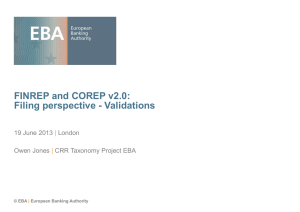Filing rules
advertisement
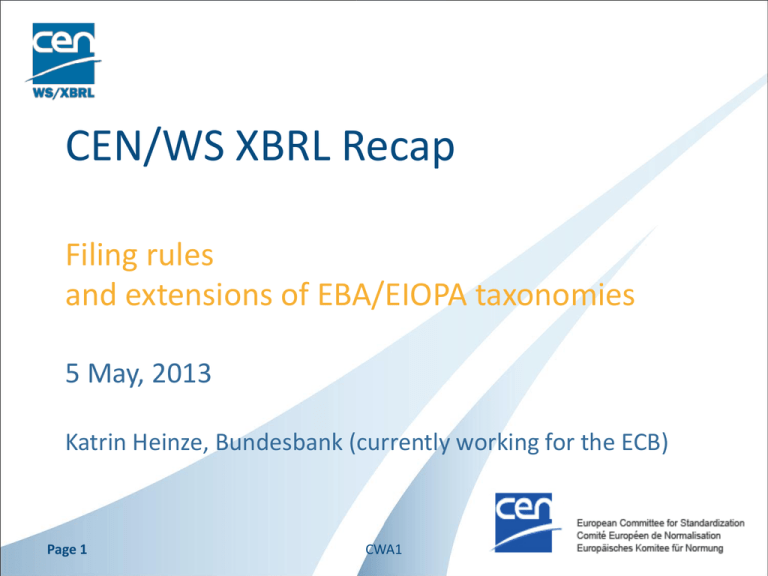
CEN/WS XBRL Recap Filing rules and extensions of EBA/EIOPA taxonomies 5 May, 2013 Katrin Heinze, Bundesbank (currently working for the ECB) Page 1 CWA1 EU principles of transparency and non-discrimination Fundamental principles of the EC Law Increasing the competitiveness and support the movement of services Member states must transpose the EU Directives with precision, clarity and transparency to enable individuals to ascertain their obligations Providing significant impulses for harmonization in different business areas One of them: ICT - information and communication technologies ICT provides services for the industrial society which are essential to be competitive against markets in and outside of the EU ICT contribute to the overall business success Precondition ICT applications must be interoperable to provide efficient access to information and their distribution In this sense: The harmonization of the supervisory reporting in Europe by using DPM and XBRL is an important field of activity. 2 Technical background for the definition of filing rules XBRL is a framework for the definition of data formats provides a high degree of flexibility for the creation of taxonomies and instance documents flexibility requires complex IT systems to react appropriately on all possible variants that the standard allows, like definition of units, accuracy of values, usage of footnotes, periods, identifiers etc. Page 3 Definition and Advantages Rules to be followed for the preparation and validation of instance documents in a XBRL filing process which place additional constraints on XBRL instance documents. Advantages Provide harmonization on a technical level Enhance the interoperability of IT systems Ease the comparison of reporting data Ease the validation of instance documents Give rules to reporting entities as guidance Decrease the reporting burden for reporting entities Enable automated tests on the rule set Page 4 XBRL Filing ? Filing Rules based on Best Practices Approach Year Status Publisher Coverage Rules on FRIS1 2004 PWD2 XII3 XBRL 2.1 - only XBRL instances Global Filing Manual 2010 Best Practices SEC, FSA Japan, IFRS XBRL Standard XBRL instances and taxonomies EDGAR Filer Manual 2013 Best Practices U.S. Securities and Exchange Commission XBRL Standard XBRL instances and taxonomies Part of the CWA1 deliverables of the standardization process of CEN/WS XBRL oriented to reporting entities preparing the filings on basis of EIOPA and EBA taxonomies Recommendations to be adopted by NCAs and European Supervisory Authorities EFL FRIS GFM Page 5 1 2 3 Financial Reporting Instance Standards Public Working Draft XBRL International Inc. Structure of the Deliverable Currently 34 rules and descriptions separated in two chapters 12 Filing syntax rules Rules for the complete document to be filed 22 Instance syntax rules Syntax rules for the instance document and its subordinated objects Contexts Facts Units Footnotes Example: Page 6 Meta model of the CEN Filing Rules Page 8 Achievements so far Reporting entity Data Point Model Harmonised Harmonised XBRL Data Format & XBRL Filing ? Harmonised? European Reporting Frameworks Page 9 European Supervisor Analysis based on the following publications CEN: European Filing Rules. December 2013 (after approval by the stakeholders) EBA: XBRL Filing Rules COREP and FINREP Taxonomy v2. March 2014 https://www.eba.europa.eu/documents/10180/502670/EBA+XBRL+Filing+Rules+for+v2.0.0.pdf Filing Manuals of the NCAs in Denmark, United Kingdom and Germany Danmarks Nationalbank: Danish XBRL Filing Rules. February 2014 https://www.finanstilsynet.dk/~/media/Temaer/2014/Fremtidigeindberetninger/Indberetningsregler_fiona.ashx FCA: COREP/FINREP Reporting Filing Manual. February 2014 http://www.fca.org.uk/static/documents/corep-finrep-filing-manual.pdf Bundesbank: Regeln der Bundesbank für das bankaufsichtliche XBRL-Meldewesen. March 2014 (only in German) http://www.bundesbank.de/Redaktion/DE/Downloads/Service/Meldewesen/Bankenaufsicht/PDF/bundesbank _filing_rules.pdf?__blob=publicationFile … 10 Comparison of the Filing Manuals Page 11 Level of harmonisation CEN <-> EBA CEN rules adopted by EBA March 2014 7 34 32 8 of 32 define a different severity 2 CEN rules Not adopted Harmonised Number of CEN rules: 34 Number of EBA rules: 39 Page 12 New Issues identified CEN <-> EBA First set of rules was reduced from 48 to 35 rules Some previously rejected rules have been added to the EBA rule set One rule seems to have a lack of details The indication of the severity is unclear is required = MUST is recommended = SHOULD; sometimes MAY 13 Level of harmonisation EBA <-> NCAs EBA rules adopted by DE, DK, UK March 2014 39 23 16 4 EBA rules Harmonised Amended Page 14 New Decrease in harmonisation 15 Problems identified EBA <-> NCAs Harmonisation on technical level is not reached International acting reporting entities have to be prepared for the different validation requirements Some based on national language-dependent description NCAs might need to amend the file for transmitting it to ECB or EBA (i.e. duplicate facts are not restricted) Software prepared for the validation of the EBA Filing Rules does not cover all rules defined across Europe Page 16 Possible counter-measures Amending the CEN Filing Rules according to the amendments introduced by EBA Interested parties? Define a clear severity for each rule Ease the description of the rule (too technical?) Raise awareness in the Eurofiling community Eurofiling workshop (Done!) Conference call Publication of the analysis results at eurofiling.info Raise the issue at EBA level Page 17 Thanks for your attention Comments or questions? Page 18 CWA1

